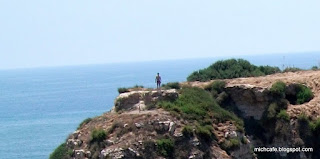 |
| Dates, blessed fruit of the Holy Month of Ramadan |
You can feel the excitement in the air everywhere around you in Dubai as it prepares for the holy month of Ramadan starting on Monday (August 1).
Vacationers are jetting back to rejoin their families. Supermarkets are fully stocked in expectation. Malls are decked with Ramadan goodies in distinct areas. Shopping carts are overflowing with supplies to feed the extended gatherings as well as the needy. Pretty soon partition panels and screens will enclose the few cafés and restaurants where non-Muslims can still eat and drink during the fasting hours.
 |
| Palms all over Dubai are shedding their yields |
Ramadan is a month of blessing, prayer, fasting and charity for more than a billion Muslims around the world, or one-fifth of humanity. Muslims believe the first verses of the Holy Qur’an were revealed during this month.
It is recounted that a caravan trader was wandering the desert near Mecca in 610 AD when a voice called to him from the night sky. It was the Angel Gabriel who told Mohammad he had been chosen to receive the word of Allah. In the days that followed, Prophet Mohammad (PBUH) spoke the verses that would be passed on as the Qur’an.
Ramadan is the ninth month of the Islamic lunar calendar, 11-12 days shorter than the Gregorian calendar. Thus Ramadan moves forward each year and eventually covers all seasons. During this month, Muslims will abstain from food and drink from first light to sunset. In Dubai’s summer months, fasting is all the more difficult with the heat and long daylight hours (4.16 a.m. till 7.06 p.m. on the first day).
Fasting, or sawm in Arabic, during Ramadan is one of the five pillars of Islam. The other four are shahada (declaration of belief in the oneness of God and acceptance of Mohammad as God’s prophet); salat (daily prayers); zakat (alms-giving); and hajj (pilgrimage to Mecca).
 |
| Breaking the fast with a date since the 7th century |
The sugar content of ripe dates is about 80%; dates are high in fiber and a good source of potassium, protein, fat and mineral products including copper, sulfur, iron, magnesium and fluoric acid. One date satisfies the minimum requirements of a balanced and healthy diet.
 |
| There are more than 600 varieties of dates |
There are more than 600 varieties of dates and among their many benefits are those to pregnant women.
According to the Qur’an, dates were the food God provided for the Virgin Mary when labor pains drove her to the trunk of a palm tree. “She cried (in her anguish): ‘Ah, would that I had died before this! Would that I had been a thing forgotten and out of sight!’ But (a voice) cried to her from beneath the (palm tree), ‘Grieve not, for thy Lord hath provided a rivulet beneath thee; and shake towards thyself the trunk of the palm tree. It will let fall fresh ripe dates upon thee. So eat and drink and cool (thine) eye. And if thou dost see anyone, say: I vowed to the Most Merciful abstinence, so I will not speak today to any human being.'"(Maryam – 23:26)
Many hadiths speak of the benefits of eating this “fruit of Paradise,” not only after fasting.
 |
| "Ajwa dates are from Paradise" |
Because they come from Madina and were singled out by the Prophet, Ajwa dates are among the most expensive and a big favorite during Ramadan.
The Prophet is also reported in the hadiths to have told his favorite wife Aisha that a household without dates is famished.
Dates have been cultivated since old times from Mesopotamia to prehistoric Egypt, possibly as early as 4000 BC. Date palm leaves are used for Palm Sunday in the Christian religion. Palm branches are also used during the Jewish Sukhot (or Feast of Tabernacles) service.
The Food and Agriculture Organization (FAO) estimated about seven million tons of dates were produced worldwide in 2007. Egypt, Iran, Saudi Arabia, Dubai and its partners in the United Arab Emirates, and Pakistan were the top five date producing countries of the world. Between them, the five countries produced 67 percent of the world’s output of dates.
 |
| Dates on palms around Dubai |
Apart from the Ajwa variety, there is the Sokari, Khidri, Wanan, Madjool, Bahri, Segai, Maktoom, Deglet Noor, Khadrawi, Sellaj, Baraka, Kholas… These are sold plain or pitted and stuffed with caramelized pecan nuts, ginger, orange peel, or almonds. Balah are those picked before they are ripe and still bitter; the Rutab are frozen semi-ripe and kept in the freezer. So many products are made of dates. I saw a sparkling date drink, date syrup, date mustard, date Balsamic vinegar, date biscuits and date and walnut cake, to name a few.
With just a couple of days to go before the Holy Month begins, don’t forget to restock dates from the diverse varieties…
-- Related post: Ramadan in Dubai, 18 August 2010





































